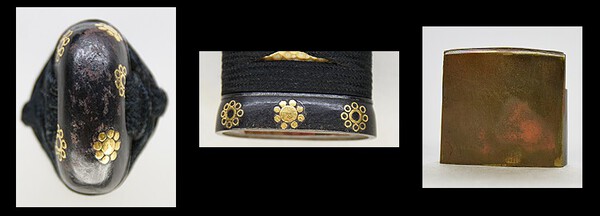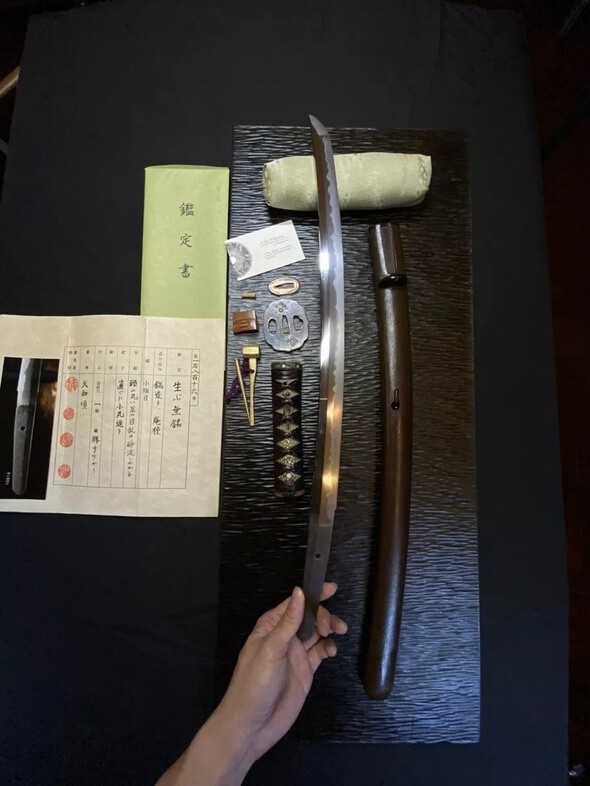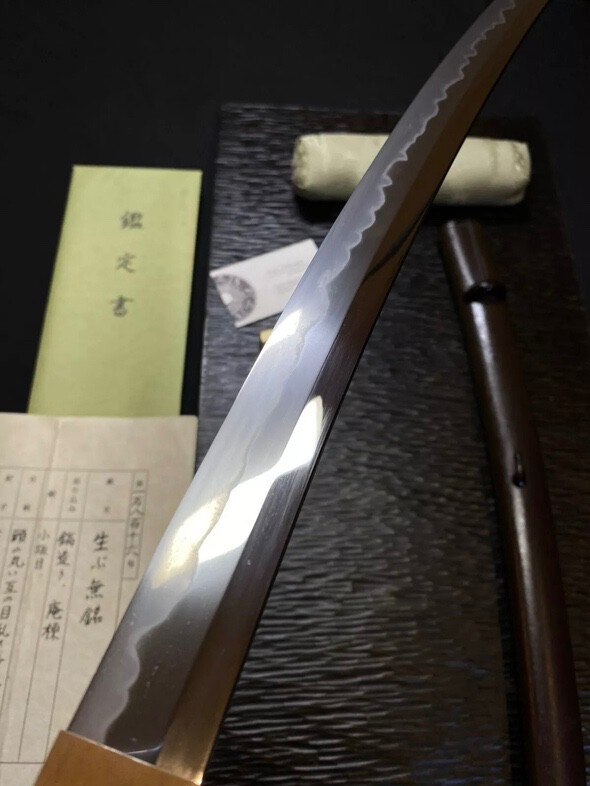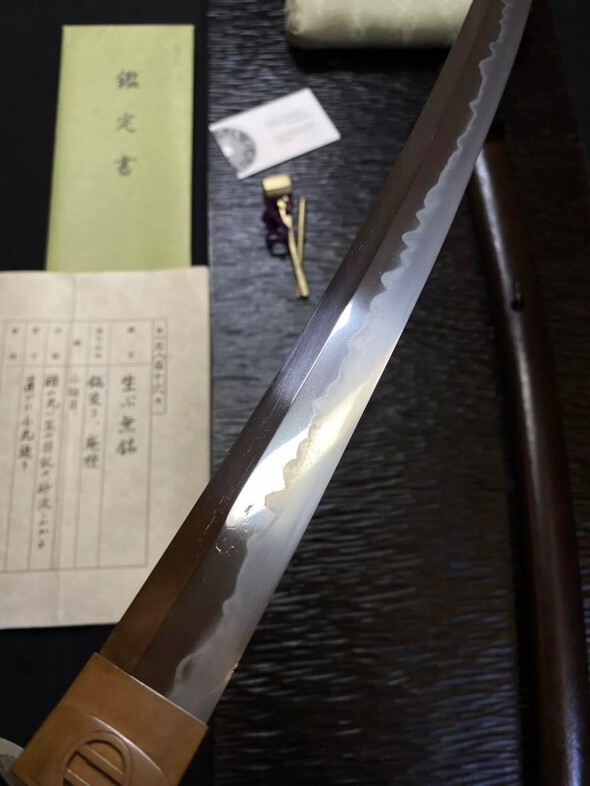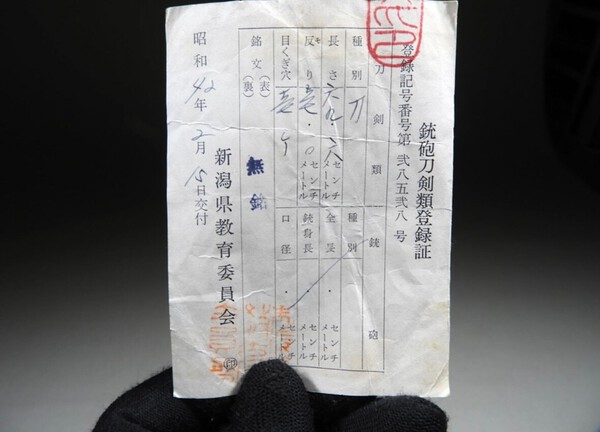
VRGC
Members-
Posts
45 -
Joined
-
Last visited
Everything posted by VRGC
-
Kaneharu Katana & Sudo Kunitsugu Wakizashi (NBTHK Hozon)
VRGC replied to L_Pan's topic in Sold Archive
PM sent -
Kaneharu Katana & Sudo Kunitsugu Wakizashi (NBTHK Hozon)
VRGC replied to L_Pan's topic in Sold Archive
Still available? I’m interested! -
Mid-Muromachi Period katana - Bingo Mihara School link
VRGC replied to VRGC's topic in General Nihonto Related Discussion
Thank you for your answer Brian. Indeed it’s not mind blowing but it feel like a solid base that covers some “nice to have”. Good to hear that I came to a similar conclusion. -
It fits my budget, time period of interest, a strong curve and has a NBTHK Hozon certificate (I have yet to see it but have have requested it from the shop). I am not after a famous smith or signed Mei but rather just a decent sword with a good enough polish. I find the link to Bingo Mihara School nice to dive into. This matches my needs but I wanted to check if I'm not missing any obvious signs with regards to price and quality / polish ect. I see a few things like some prominent spots around the middle and towards the end of the katana but Im not too bothered. It’s also from a Japanese retail shop that was recommended by a fellow Dutch NMB member. Listing Details: No.: 40 Type: Sword Signature: Unsigned (Mihara) (Bingo) (Sanyo-do) Era: Mid Muromachi Period Length: 63.9 cm Curvature: 1.6 cm Thickness: 0.61 cm Certificate: Hozon Token (NBTHK) Quality: Standard Product Included: White Scabbard and Mountings Price: ¥380,000 Description: Construction: Honzukuri Iorimune (main construction with high ridge lines) Tang: Machi-okuri (shortened tang) Grain: Small Itame-hada mixed with straight grains, well-packed Surface: Fine Ji-nie (small particles of martensite) densely packed, with fine Chikei (dark lines) visible, and a faint Utsuri (shadow pattern) appearing Hamon (Temper Pattern): Midare (irregular) style with shallow undulations, mixed with small Gunome (zigzag), and pointed shapes Nioi-kuchi (Hamon's border): Slightly thick with well-formed small Nie (small martensite crystals) Additional Features: Hotsure (fraying), double temper lines, small Ashi (legs), Hada (grain) activity, Kin-suji (golden lines), and Sunagashi (sandy lines) visible. The Nioi-kuchi is bright and clear. School: Early Muromachi Period Bingo Mihara School Mountings: Includes black lacquered scabbard with fittings. (Hozon Token)
-
Looking to buy my second nihonto katana
VRGC replied to VRGC's topic in General Nihonto Related Discussion
I learnt this from another member: Fujiwara was an honorary title bestowed upon various swordsmiths. There were also Koto period smiths with this title. It is not indicative of period. -
Looking to buy my second nihonto katana
VRGC replied to VRGC's topic in General Nihonto Related Discussion
As I learned from another member: Many smiths added Fujiwara on or off on their mei. Shape is indeed more later looking, but such straight sugata already existed in the Kamakura era. They were just far from common but not unheard of. -
Looking to buy my second nihonto katana
VRGC replied to VRGC's topic in General Nihonto Related Discussion
Kazushige Tsuruta from Aoi Has spoken (not the most detailed explanation). Based on his expertise it is a Muromachi period sword: “According to the book on swords, this piece is described as being from the late Muromachi period, and I have come to the same conclusion.” “I believe it is by Yamashiro Nobuyoshi.” -
Looking to buy my second nihonto katana
VRGC replied to VRGC's topic in General Nihonto Related Discussion
-
Looking to buy my second nihonto katana
VRGC replied to VRGC's topic in General Nihonto Related Discussion
1) definitely 2) yes, but it’s is something I will question the retail shop with (based on there answer I can make a decision). Plus some research on my side -
Looking to buy my second nihonto katana
VRGC replied to VRGC's topic in General Nihonto Related Discussion
This is most likely the smith: https://nihontoclub.com/smiths/NOB590 "平安城住信吉" (Heianjō-jū Nobuyoshi) and "平安城住藤原信吉" (Heianjō-jū Fujiwara Nobuyoshi) refer to the same swordsmith. The addition of "藤原" (Fujiwara) indicates that Nobuyoshi belonged to the Fujiwara clan. Thus, the full name "平安城住藤原信吉" simply provides more detail about his family background. Nobuyoshi (信吉) would be categorized as “中上作” (Chūjō-saku), “middle-upper grade” of craftsmanship. I believe he has a rating of 15 in the Hawley reference Also I didn’t add it above but you can see that there is (what seems to me) a mei comparison happening here on the NBTHK Tokubetsu Kicho Paper. There are two nakago being compared. It seems like it’s a reference to determine the Mei (I could be wrong) but the nakago they look slightly different in overall length (although have a similar build). I guess they are looking for similarities with regards to the mei signature for this smith, See picture -
Looking to buy my second nihonto katana
VRGC replied to VRGC's topic in General Nihonto Related Discussion
Nobuyoshi (信吉) would be categorized as “中上作” (Chūjō-saku), “middle-upper grade” of craftsmanship. I believe he has a rating of 15 in the Hawley reference. -
Hey NMB members, I have been looking for a Muromachi period katana in the mid-level and above quality. I have found something in my budget from Aio-Art. Before I make the purchase, I wanted to check in with you guys. My only concern would be the Mei, one character is basically not visible (I guess rust overtime) but with all the documentation, I doubt it has any reason to be a fake/misleading Mei: - NBTHK Hozon Paper - NBTHK Tokubetsu Kicho Paper - Aoi-Art estimation Paper - whole oshigata Would this be an issue for reselling it? I couldnt find much on the smith but i have found very similar from the same lineage 信吉 Nobuyoshi. https://nihontoclub.com/smiths/NOB590 Could it be this smith? Here’s the seller description: Katana in Shirasaya Inscription: Heianjo Ju Fujiwara Nobuyoshi 平安城住藤原信吉 (We divide 4 sections for each sword as Saijyo saku, Jyojyo saku Jyo saku and regular saku) This sword belongs to Jyo Jyo saku ranking. Habaki: gold-foiled double habaki Length: 76.2 cm (30.0 in) Sori: 0.8 cm (0.83 in) Mekugi hole: 1 Width at base: 3.2 cm (1.3 in) Width at tip: 2.1 cm (0.8 in) Thickness: 0.8 cm (0.3 in) Weight: 860 g Era: the late Muromachi period, around Tenbun era, the 16th century. Shape: wide and thick blade with small sori. Jigane: well-fordged ko-itame hada Hamon: Niedeki gunome midare with ashi and deep nioikuchi. There are a lot of Sunagashi and Kinsuji in the hamon. Features: Heianjo Ju Fujiwara Nobuyoshi, the son of Nagayoshi was active in Kyoto in the late Muromachi period. The hamon is bright and beautiful. NBTHK Hozon Paper NBTHK Tokubetsu Kicho Paper Aoi-Art estimation Paper whole oshigata Prices:400,000 JPY-.
-
Im sold, am I missing anything?
VRGC replied to VRGC's topic in Auctions and Online Sales or Sellers
Thanks Barry, it seems I am greeted by a 50+ year legend in the field, the honour is mine haha okay, I was also noticing this white line, initially I though a scratch but you are giving a shinogi ji is not flat. How does that white line show that? Because it has a ‘S’ curve to it? It should look completely straight? thanks victor -
Im sold, am I missing anything?
VRGC replied to VRGC's topic in Auctions and Online Sales or Sellers
Hi John, I see what you mean, I am learning so much and I’m so glad I can get these lesson by checking in with you guys. Thanfully I am not quick to buy a nihonto and like to do my research… it’s a process that I’m going through to find a decent wakizashi and it katana with a decent look/ authentic and that checks a least all the basics… that seems harder than I though. I am pushing for the €1300 €1500 and hope to find something that is somewhat acceptable and not completely ruined as by this bad polishing. Problem with that kind of money is i don’t feel comfortable buying outside of an official dealer. But the official dealers start mostly from €2000. Right now that’s not something I feel comfortable spending on. So it’s a challenge but I tell myself that the right nihonto to will come to me at some point -
Im sold, am I missing anything?
VRGC replied to VRGC's topic in Auctions and Online Sales or Sellers
How do you see that, what makes it dreadful? -
After searching for some time I have found a wakizashi that matches my interest. the polish looks decent, it has an NBTHK paper seems to match the tang (but does the Japanese text match the blade?), a beautiful clear Hamon and the Koshirae..I find it overall beautiful… but as always, I feel like I might be missing something behind the beauty. Therefore I come to you for (hopefully) unbiased advice and expert view. Any question I should ask the seller before hand? what are your thoughts, I thank you in advance as always victor seller description (sorry it’s a long one): Price €1373 Wazamono Wakizashi in fine Koshirae, with NTHK certificate, unsigned, attributed to: 伝 Den 越前三代播磨大掾重高 Echizen Sandai Harima Daijo Shigetaka The 重高Shigetake smithline of 越前Echizen is a representational smithline of the 越前新刀Echizen Shinto school, which the lineage started when the first generation 重高Shigetaka, a student under the famous 美濃Mino smith 兼則Kanenori, migrated to the country of 越前Echizen together with his teacher during Kanbun period (1661~1673) of early Edo period. From then, the school continued their work with great reputation all the way until the 11th generation during the 嘉永Kaie period (1848~1855). The first 3 generations received the title of 播磨守Harima no Kami, The 越前重高Echizen Shigetaka smith group's works were known for great 切れ味Kireaji "sharpness", which their works received the ranking of 業物Wazamono during Edo period's 試し斬りTameshigiri test cutting system. As per the attribution of NTHK, this particular blade is made by the 3rd generation. Note that the 伝Den ("told to be") notation before the attribution means that they are not one hundred percent certain about this attribution, but only thinking this is a likely and probable opinion. as shown in the photos, this particular blade is overall in excellent condition with no significant issues observed. It's overall a rather typical Echizen Shinto blade with such Sugata and Gunome style Hamon. One thing to note that the current polish is not one hundred percent traditionally done, though this doesn't affect enjoying the blade. The Koshirae is very decently done as well, with a lacqueres leather Tsukamaki on the Tsuka, mounted with high quality leaf and spider motif Menuki as well as ratten weaven pattern plum flower motif Fuchikashira as well as Habaki with 丸に二つ引きMaru-ni-Futatsu-biki style 家紋Kamon family crest engraving. Overall a very enjoyable set of art for display and enjoyment Nagasa: 1 Shaku 4 Sun 9 Bu ~45.15cm or 17.78inches
-
Hey Lex, interesting to have a Dutch perspective on Nihonto. I will be at the event in Utrech this weekend, I have booked tickets some time ago now. Alright, I have not heard of Dutch Token vereniging. Will check it out, I will keep you in mind for anything nihonto Netherlands
-
Hi, which list, maybe I missed it in all the comments. I mean strong enough to bite the occasional bullet definilty but I suppose it depends how big the bullet is each time… hopefully smaller as time goes by thanks
-
Going to the Japan Art Expo in Utrecht, I believe one of the few in Europe (maybe the only one). They have talks/presentations, some nihonto, experts in the field and other Japanese antique. I looking forward to it!
-
That’s already a very good start Brian, thanks a lot! I appreciate you taking the time to put down some valuable things.
-
Good day everyone, If you were to create a checklist for buying a Nihonto, what essential dos and don'ts would it include? I'm looking for a simple, concise guide that covers the very basics things a beginner should avoid. Additionally, what mistakes did you make when you first started that you realize now, years later (That everyone should know)? Thanks in advance for your help and input. Best, Victor
-
Does this katana match its proposed value by seller?
VRGC replied to VRGC's topic in General Nihonto Related Discussion
I see, the tempered part of the blade is no longer able to hold a hard edge. -
Does this katana match its proposed value by seller?
VRGC replied to VRGC's topic in General Nihonto Related Discussion
So that means it’s potentially badly re-polished, several times or once badly? Or has the sword been “trimmed” as in material removed too close to the Hamon? If not I don’t understand the significance. -
Does this katana match its proposed value by seller?
VRGC replied to VRGC's topic in General Nihonto Related Discussion
Do you mean that the Hamon touches at one or two spots the edge of the blade? -
(sorry if the photos don’t fit the rules but they are from the seller and also and also I may have put this post in the wrong disccussion…) but anyhow, let’s get started haha. Hello, I’m looking to purchase this katana but I want to check if its value is correct, seller puts is at €1251,93. Also if it matches the Edo era (before 1868) blades. If you can help me with that, I would be grateful. I have attached the photos below. Seller’s description: Japan antique sword long KATANA dynamic blade Hamon is a super beautiful sword from "Togari-Gunome". The width at the base of the blade is 32mm, thick and strong, and it is a beautiful sword with no damage! This is a masterpiece model with a form that is considered to be representativeof the high quality of the Shinto era. Hamon is a "Togari-Gunome", a straight blade of Midare-Hamon's magnificent Mumei. Its linear shape makes the sword appear much longer than it actually is. Of course there is no damage to note. Over the years, the exterior Shirosaya has also naturally changed to the dark brown color of antique food, giving it a dignified atmosphere. Registration date, February 1962, jurisdiction Board of Education, Length (blade length), 69.6 cm, ( in) Curve (Sori), 1.0 cm ( in), Mekugi hole, 1 place Types of swords, Katana Inscription (front side) , Mumei (Nameless) (Back side) none * HABAKI, Old Copper * MOTOHABA, 32.0 mm, * MOTOKASANE, 7.5 mm, * SAKIHABA, 21.0 mm, * SAKIKASANE, 5.5 mm, * NAKAGO length, 123 mm, ( in) * Weighing only swords, 235g, ( oz) * Production era, Edo era (before1868)











